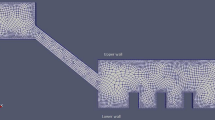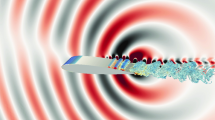Abstract
The understanding of air-flow in enclosed spaces plays a key role to designing ventilation systems and indoor environment. The computational fluid dynamics aspects dictate that the large eddy simulation (LES) offers a subtle means to analyze complex flows with recirculation and streamline curvature effects, providing more robust and accurate details than those of Reynolds-averaged Navier–Stokes simulations. This work assesses the performance of two zero-equation sub-grid scale models: the Rahman–Agarwal–Siikonen–Taghinia (RAST) model with a single grid-filter and the dynamic Smagorinsky model with grid-filter and test-filter scales. This in turn allows a cross-comparison of the effect of two different LES methods in simulating indoor air-flows with forced and mixed (natural + forced) convection. A better performance against experiments is indicated with the RAST model in wall-bounded non-equilibrium indoor air-flows; this is due to its sensitivity toward both the shear and vorticity parameters.















Similar content being viewed by others
Abbreviations
- \(C_\mu\) :
-
Eddy-viscosity coefficient
- \(\bar{C}_s\) :
-
Smagorinsky coefficient
- G :
-
Filter function
- g :
-
Gravitational acceleration
- k :
-
Total turbulent kinetic energy
- \(L_{ij}\) :
-
Leonard stress
- Pr :
-
Molecular Prandtl number
- \(Pr_{sgs}\) :
-
Sub-grid scale Prandtl number
- Re :
-
Reynolds number
- \(\bar{S}_{ij}\) :
-
Resolved strain-rate tensor
- T :
-
Temperature
- \(\bar{u}_i\) :
-
Grid-filter velocities
- \(\tilde{\bar{u}}_i\) :
-
Test-filter velocities
- \(\bar{u}_\tau\) :
-
Friction velocity
- \(\overline{W}_{ij}\) :
-
Resolved vorticity tensor
- \(y^+\) :
-
Dimensionless wall distance \((\bar{u}_\tau y/\nu )\)
- \(\beta\) :
-
Thermal expansion coefficient
- \(\delta _{i,j}\) :
-
Kronecker’s delta
- \(\varDelta t\) :
-
Time step
- \(\bar{\varDelta }\) :
-
Grid-filter width
- \(\tilde{\varDelta }\) :
-
Test-filter width
- \(\nu ,\nu _T\) :
-
Laminar and turbulent viscosities
- \(\bar{\theta }_i\) :
-
Grid-filter temperature
- \(\tilde{\bar{\theta }}_i\) :
-
Test-filter temperature
- \(\rho\) :
-
Density
- \(\tau _{i,j}\) :
-
Sub-grid scale stress tensor
- CFD:
-
Computational fluid dynamics
- DSM:
-
Dynamic Smagorinsky model
- LES:
-
Large eddy simulation
- RANS:
-
Reynolds averaged Navier–Stokes
- RAST:
-
Rahman–Agarwal–Siikonen–Taghinia
- SGS:
-
Sub-grid scale
- i, j :
-
Variable numbers
- in :
-
Inlet condition
- out :
-
Outlet condition
References
Chen Q (1995) Comparison of different \(k\)-\(\epsilon\) models for indoor air flow computations. Numer Heat Transf Part B 28:353–369
Chen Q (1996) Prediction of room air motion by Reynolds-stress model. Build Environ 31(3):233–244
Chen Q (1997) Computational fluid dynamics for HVAC: successes and failures. ASHRAE Trans 103(Part 1):178–187
Luo S, Roux B (2004) Modeling of the HESCO nozzle diffuser used in IEA annex 20 experimental test room. Build Environ 39:367–384
Stamou A, Katsiris I (2006) Verification of a CFD model for indoor airflow and heat transfer. Build Environ 41:1171–1181
Zhai Z, Zhang Z, Zhang W, Chen Q (2007) Evaluation of various turbulence models in predicting airflow and turbulence in enclosed environments by CFD. Part 1: summary of prevalent turbulence models. HVAC&R Res 13(6):871–886
Zhang Z, Zhang W, Zhai JZ, Chen Q (2007) Evaluation of various turbulence models in predicting airflow and turbulence in enclosed environments by CFD. Part 2: comparison with experimental data from literature. HVAC&R Res 13(6):871–886
Cao GY, Ruponen M, Paavilainen R, Kurnitski J (2011) Modeling and simulation of the near-wall velocity of a turbulent ceiling attached plane jet after its impingement with the corner. Build Environ 46:489–500
Smagorinsky J (1963) General circulation experiments with the primitive equations, I. The basic experiment. Mon Weather Rev 91:99–164
Germano M, Piomelli U, Moin P, Cabot WH (1991) A dynamic subgrid-scale eddy viscosity model. Phys Fluids A 3:1760–1765
Olsson M, Fuchs L (1996) Large eddy simulation of proxi- mal region of a spatially developing circular jet. Phys Fluids 8:2125–2137
Ghosal S, Lund T, Moin P, Akselvoll K (1995) A dynamic localization model for large-eddy simulation of turbulent flows. J Fluid Mech 286:229–255
Meneveau C, Lund T, Cabot WH (1996) A Lagrangian dynamic sub-grid scale model of turbulence. J Fluid Mech 319:315–353
Taghinia J, Rahman MM, Siikonen T, Agarwal RK (2014) A sub-grid scale model with non-traditional eddy-viscosity coefficient. In: 7th AIAA theoretical fluid mechanics conference. doi:10.2514/6.2014-3212
Rahman MM, Siikonen T (2006) An explicit algebraic Reynolds stress model in turbulence. Int J Numer Methods Fluids 52:1135–1157
Rahman MM, Siikonen T (2005) An eddy viscosity model with near-wall modifications. Int J Numer Methods Fluids 49:975–997
Nicoud F, Ducros F (1999) Subgrid-scale stress modeling based on the square of the velocity gradient tensor. Flow Turbul Combust 62:183–200
Vreman AW (2004) An eddy-viscosity subgrid-scale model for turbulent shear flow: algebric theory and applications. Phys Fluids 16:3670–3681
Moin P, Kim J (1982) Numerical investigation of turbulent channel flow. J Fluid Mech 118:341–377
Lilly DK (1992) A proposed modification of the Germano subgrid-scale closure model. Phys Fluids 4(3):633–635
Rahman MM, Miettien A, Siikonen T (1996) Modified SIMPLE formulation on a collocated grid with an assessment of the simplified QUICK scheme. Numer Heat Transf Part B 30:291–314
Rahman MM, Siikonen T, Miettien A (1997) A pressure-correction method for solving fluid flow problems on a collocated grid. Numer Heat Transf Part B 32:63–84
Majander P (2000) Developments in large eddy simulation. Report 128, Aalto University. ISBN 951-22-4861-1
Davidson L (2001) Hybrid LES-RANS: a combination of a one-equation SGS model and a \(k\)-\(\omega\) model for predicting recirculating flows. In: ECCOMAS CFD conference, Swansen, UK
Krajnovic K, Davidson L (2006) A mixed one-equation subgrid model for large-eddy simulation. Int J Heat Fluid Flow 27:402–415
Nielsen PV, Restivo A, Whitelaw JH (1978) The velocity characteristics of ventilated room. ASME J Fluids Eng 100:291–298
Blay D, Mergui S, Niculae C (1992) Confined turbulent mixed convection in the presence of a horizontal buoyant wall jet. In: Chen TS, Chu TY (eds) Fundamentals of mixed convection, HTD, vol 213. ASME, New York, pp 65–72
Taghinia J, Rahman MM, Siikonen T (2014) Numerical investigation of twin-jet impingement with hybrid-type turbulence modeling. Appl Therm Eng 73(1):648–657
Chen HJ, Moshfegh B, Cehlin M (2012) Numerical investigation of the flow behavior of an isothermal impinging jet in a room. Build Environ 49:154–166
Author information
Authors and Affiliations
Corresponding author
Rights and permissions
About this article
Cite this article
Taghinia, J., Rahman, M.M. & Tse, T.K. Assessment of zero-equation SGS models for simulating indoor environment. Heat Mass Transfer 52, 2781–2794 (2016). https://doi.org/10.1007/s00231-016-1776-7
Received:
Accepted:
Published:
Issue Date:
DOI: https://doi.org/10.1007/s00231-016-1776-7




